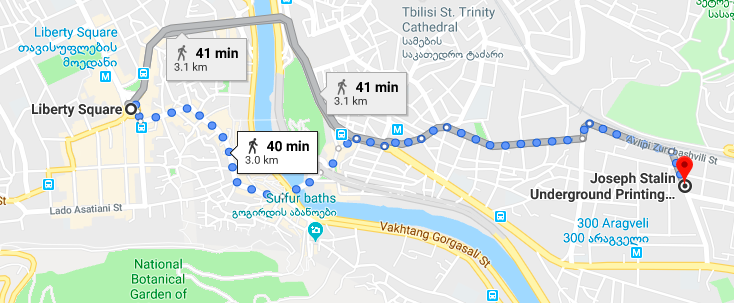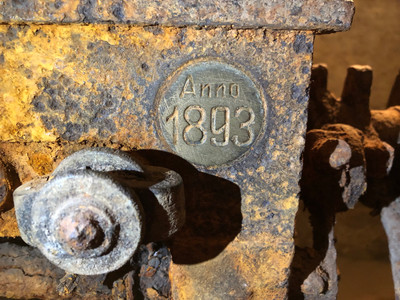Stalin's Underground Printing House
- Globepouncing
- May 6, 2019
- 4 min read
Updated: May 21, 2021
Fun fact: Joseph Stalin was Georgian. Born Ioseb Jughashvili, he was raised in a town called Gori, which is in present-day Georgia, and he grew up speaking Georgian. These details are, of course, overshadowed by the fact that today's Georgia was part of the Russian Empire at the time of Stalin's birth and was absorbed into the Soviet Union shortly after its inception.
As a young revolutionary, Stalin took up residence in Georgia's capital, Tbilisi. Thanks to this residency, one of the coolest places to see in Tbilisi today is the Joseph Stalin Underground Printing House. Called a museum, in truth it is more a shrine to Stalin and his revolutionary activities as well as the functioning headquarters for the United Communist Party of Georgia.
If you're staying near Freedom (Liberty) Square or anywhere near Tbilisi's Old Town, you can reach the Stalin Underground Printing House with about a 40-minute walk.
What might be of further interest to you lovers-of-life out there is that to get there, one climbs the 'Wine Rise' and passes the thickest concentration of coffee shops and old-style bakeries that we found in Tbilisi along Aleksandre Tsturtsumia St. At one of the bakeries near the turn onto Telavi St. (bottom map pic above), we found the greatest loaf of apple bread one could ever hope for (see more on Georgian breads in our Georgian food article).
Back to Stalin.
You've now climbed the Wine Rise, passed a sculpture of the actors from a Georgian movie called Mimino, passed and perhaps patronized a bunch of coffee shops and bakeries on Aleksandre Tsturtsumia St., turned left on Telavi St., and veered right onto and turned right off of Avlipi Zurabashvili St. for the street on which the SUPH is. It will be on your left. You'll know you're there when you see these doors tastefully adorned with the hammer and sickle.
As mentioned earlier, the museum doubles as the Georgian Communist Party HQ. The main building is a tad sparse and spooky, but it's pretty cool - it's living history. We had the place to ourselves, too, so the 'manager,' a Party leader named Jiuli Sikmashvili, a rugged older man with a firm handshake and even firmer political convictions, gave us a private tour.

He showed us his office and explained to us many of the photos - some old but some quite recent - hanging there and in the main hall. He has original photos of Stalin and Mao Zedong, Stalin's Communist Party registration (he's No. 2; Lenin's No. 1), and many other fascinating pieces of history to complement the main attraction. Jiuli's English was not the strongest, but it was certainly better than our Russian! He was very patient with us and was more than willing to answer our questions. His explanations certainly got the point across regarding the many items in which we expressed interest.
The press is still in its original location, which is why it has suffered rust death, but this adds to its mystique. This item has incredible historical value and unparalleled, gritty charm, yet it remains here instead of moving to a museum. This likely has a lot to do with the Georgian majority's view on Stalin and on Communism in general, but it's a remarkable piece nonetheless, and it makes this 'museum' like no place else.
Accessing the press is much easier for us now than it was for Stalin and his comrades over 100 years ago. In order to reach it, they had to descend a well in a shed outside the house, crawl through a tunnel, and then climb back up another shaft into the printing room, which was located directly beneath the house. These days, spoiled as we are, we can just go down a spiral staircase to the basement of the house where the press lives. Comrade Sikmashvili also pointed out a bell that acted as a lifeline from the house to the revolutionary printers: one ding meant pause, two meant keep going, and three meant dinner. He had a lovely, wry sense of humor.
A German press, it was manufactured in Augsburg in 1893. It looks like it should be covered in barnacles because of the many floods it has withstood. In fact, the basement was only drained permanently relatively recently thanks to help from - you guessed it - China. The Communists receive no love from the Georgian government, but the Chinese have been a modern lifeline for the site - a 21st century bell, if you will.
The Stalin Underground Printing House offers a stark counterpoint to the majority of the discourse surrounding the Soviet era in Georgia. The National Museum and many others do not view the period of Soviet Occupation with favor. As with much of history, we imagine that the truth is lost somewhere in the middle, and we are grateful to be able to hear divergent opinions from curious characters such as Comrade Sikmashvili. This is what I love about history - and why I love to get out of the classroom!
If you found this article helpful, sign up to become a member and find us on your favorite social media platform. Paws for travel!















































Komentáře